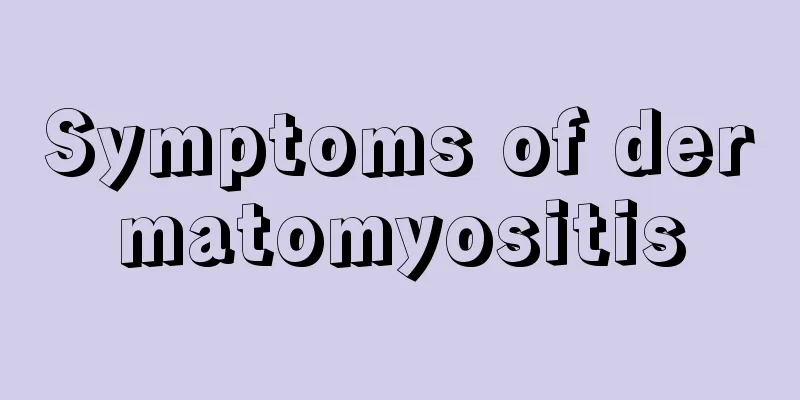Symptoms of dermatomyositis

|
There are many types of common diseases, and we need good methods to treat them. If you want to treat your own diseases well, you need to choose the correct treatment method, which will be of great help in stabilizing the patient's disease. So what are the symptoms of dermatomyositis? Many people are not very clear about dermatomyositis, and they don’t know what method to choose when dealing with this type of disease. Before treating dermatomyositis, it is necessary to have a comprehensive understanding of all aspects of this type of disease, which is conducive to the stabilization of the disease. So what are the symptoms of dermatomyositis? The following is a detailed introduction so that the disease can be improved. Symptoms of dermatomyositis: Dermatomyositis can also be clinically called a diffuse autoimmune system disease. The clinical manifestations of different patients are not the same. Clinically, it is divided into four symptoms according to the different damaged organs: 1. Heart Nearly 1/4 of patients have myocarditis. Atrial and ventricular arrhythmias, atrioventricular block or bundle branch block may occur, and in severe cases, heart failure may occur. Hormones are effective for heart disease, but those who develop congestive heart failure and atrioventricular conduction block have a poor prognosis. 2. Skin Dermatomyositis has skin lesions. Clinically, skin lesions vary greatly, and the degree of skin lesions is often not parallel to the degree of muscle lesions, and the time of occurrence is also uncertain. Skin lesions and myositis can occur simultaneously or one after the other. About 25% of patients experience simultaneous occurrence, about 50% have skin lesions occur first, and only 15% experience muscle weakness first. The rash of dermatomyositis is diverse, but the typical rash is diffuse erythema in the V-zone of the face, neck, and upper chest, as well as an erythematous and scaly rash on the extensor side of the joints. Atrophy may occur in the middle of the rash. 60% to 80% of DM patients may develop red or purple-red, rice- to mung-bean-sized, round, flat or pointed papules on the metacarpophalangeal joints and proximal interphalangeal joints, or on the elbows, extensor surfaces of the knees and medial malleolus. These papules are called Gottron papules and are quite characteristic. Patients may develop a distinctive lavender swelling on the upper eyelid, called a heliotropic rash, which is also one of the characteristics of this disease. 3. Lungs According to clinical statistics, 5% to 10% of patients develop interstitial pulmonary fibrosis, which leads to lung dysfunction, shortness of breath, and difficulty breathing. Patients with interstitial lung disease have a variety of clinical manifestations. Acute interstitial lung disease may cause fever, dry cough, dyspnea, and cyanosis, and does not necessarily present with muscle weakness. However, the disease progresses rapidly and respiratory failure may occur, often leading to death within 6 months. Chronic interstitial lung disease has a slow and insidious onset, with symptoms such as dry cough and progressive dyspnea, which are easily accompanied by lung infections and muscle weakness. Early signs are not obvious. In addition, due to weakness of the pharyngeal muscles, swallowing difficulties may occur, which may easily lead to aspiration pneumonia. 4. Muscle Almost all patients have skeletal muscle weakness. Muscles in any part of the body may be affected, but the most common involvements are the proximal muscles of the limbs, neck flexors, paraspinal muscles, and pharyngeal muscles; facial muscles are occasionally affected. The onset of this disease is usually insidious, and the condition usually develops to a peak within a few weeks or months. It usually takes 3 to 6 months for patients to go to the hospital for treatment from the time they feel weak. A few have acute or subacute attacks. In addition to muscle weakness, patients also experience myalgia and/or muscle tenderness. Through the above introduction, we have a good understanding of the symptoms of dermatomyositis. After suffering from this disease, patients also need to pay attention to their diet during treatment. When treating this type of disease, diet cannot be carried out casually. This will not help the treatment of the disease itself. This should also be noted. |
<<: Causes of frequent urination
Recommend
Causes of hypoxemia
Many people may not be particularly familiar with...
What is the blood test for when you are pregnant?
We have all had the experience of having a blood ...
Can you get pregnant if you have teratoma
Many female friends have discovered teratomas dur...
What causes left ethmoid sinus osteoma?
The formation of left ethmoid osteoma is usually ...
Differential diagnosis method of pituitary tumor
Many people think that if they have a tumor, they...
Can children come into contact with the patient undergoing chemotherapy for bone cancer?
Bone tumors are tumors that occur in bones or the...
Specific hypoglycemic drugs
There are many kinds of blood sugar lowering drug...
Why do we need to apply essential oils during scraping
Gua Sha has many benefits for the body. Generally...
Can a malignant tumor in the stomach be cured?
Malignant gastric tumors can be treated with surg...
What's wrong with the swelling and soreness in the thigh
So far, many people have experienced uncomfortabl...
What are the symptoms of shoulder bone cancer
Symptoms of shoulder bone cancer include local pa...
The benefits of TCM in treating advanced laryngeal cancer
Choosing the appropriate treatment method for pat...
What is the reason for insomnia at night
Do we feel that it is very easy to suffer from in...
Is ovarian tumor a fatal disease?
Ovarian tumor is one of the most common gynecolog...
Can pearl powder remove acne? How to remove it?
Acne is a symptom that is annoying to everyone. A...









